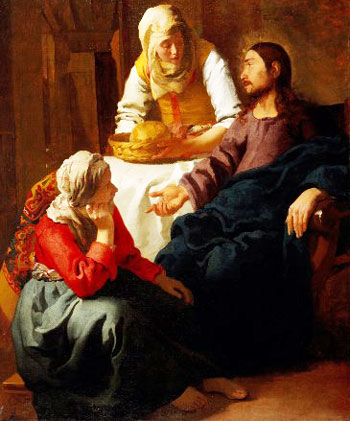
“ Christ in Home of Martha and Mary ” – Jan Vermeer (1655)
Fifth Sunday in Lent – John 12:1-8, March 13
We are a week from Holy Week and Jesus is on the way to Jerusalem, visiting the home of Lazarus. (In Year A we raise him from the dead). This year it is dinner party with Mary, Martha who are sisters, Lazarus, their brother and Judas – and maybe others.
The major disruption in this scripture is Mary taking some costly perfume and anointing Jesus feet . Mary’s gift exceeds extravagance. She expends a pound of perfume valued at about the yearly income of a manual laborer. This is both a sign of Jesus’ kingship and its formal announcement. Usually annointing was done for a specific purpose – for healing, as part of the ritual for the dead. This action anticipates the latter. Luke reveals her as a model disciple, for the washing and wiping of feet expresses a unity with Jesus (13:8) and reflects his command (13:14-15).
Mary’s actions also anticipate Jesus’ later teaching to the disciples. Mary wipes Jesus’ feet with her hair, the same action he takes in the next chapter when he washes his disciples’ feet and wipes them with the towel tied around his body. The perfume is a contrast with the stench of Lazarus tomb.
Judas enters for the first time and criticizes Mary spending money for buying the perfume rather than giving it to the poor. His concern for the poor is merely a ruse to cover his own greed. He is the direct contrast with Mary’s devotion to Jesus. How many people do we know that use groups or causes for their own benefit ?
Jesus’ response to Judas is direct and it is not like he talking to Judas as a villain. Jesus speaks more to us, to those who wonder if Mary’s apparent recklessness sets a dangerous precedent. When he says, "You always have the poor with you," he does not diminish the seriousness of poverty and the imperative for charity. We can look back to Deuteronomy 15:11, which commands generosity toward the poor precisely "since there will never cease to be some in need on the earth." As punctuated by the anointing for burial, Jesus looks toward his death, contrasting his impending departure with the perennial opportunity to serve the poor. The specter of Jesus’ death makes a deed like Mary’s strangely appropriate, because it emanates from love and expresses understanding about Jesus and what he must do.
Read the full Lectionary Commentary
Palma il Vecchio, “Christ and the Adulteress,” circa 1525–1528
Palma il Vecchio’s Christ and the Adulteress invites us into the crowd standing with the Pharisees to hear how Jesus will judge the woman caught in adultery. Palma il Vecchio’s depiction invites us into close proximity with Christ, the woman, and three Pharisees, creating an intimacy that inevitably leads one to examine his or her conscience. Christ’s direct gaze at us, the audience, reinforces this proximity and demands a look inward.
The woman in this scene is modeled after Violante, an ambiguous figure in the painter’s life, whom he regarded as a daughter. Her face appears frequently in Palma’s work. Rather than an ashamed, frightened, or penitent face, the face of this woman is somewhat defiant, unconvinced that her accusers have the right to charge her. Her raised eyebrow is evocative: it is as if she has owned up to her adultery, while at the same time remaining skeptical that her accusers are any better than she is. In this one lifted eyebrow, Palma tells us the story of “Let anyone among you who is without sin be the first to throw a stone.” While these are Christ’s words in John’s Gospel, here the words echo from the woman’s expression. To be a carrier of God’s Word gives her a vocation and returns to her the dignity that is stripped from her when she is labeled an adulteress and marked for execution.
If the woman’s raised eyebrow communicates the sin and hypocrisy present in this story, Christ’s direct gaze at us is the visual depiction of the words: “Neither do I condemn you. Go your way, and from now on do not sin again.” His gaze is gentle but honest, firm but encouraging. It is a gaze of truth and life, the same gaze perhaps that fell upon the Samaritan woman at the well, or the penitent woman who shed tears on Jesus’ feet. In this image, the gaze rests not on the woman caught in adultery, but rather on us.
Meeting Christ’s gaze is an opportunity for conversion. It is a chance to come into Christ’s truth and life, and to discover once again the dignity and vocation of being God’s beloved.
Commentary is by Daniella Zsupan-Jerome, assistant professor of liturgy, catechesis, and evangelization at Loyola University New Orleans.
